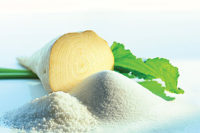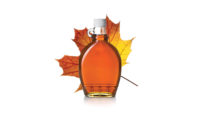Natural and alternative sweeteners for dairy foods
Health advocates have been whacking the sugar piñata. Consumers say they are cutting back, but sales receipts tell a different story. Dairy processors seek sweetening systems that allow for flavor but reduce the calorie count.

Sweeteners and sugar play an important functional role in ice cream. They depress the freezing point so that the ice cream can be scooped easily from a carton. Photo courtesy of Beneo

Consumers might say they are decreasing their consumption of sugar, but sales figures show otherwise. Taste, it seems, trumps good intentions. Photo courtesy of Sensus

The sweetness of a food, says an ingredient supplier, is the sum of multiple experiences: the speed of taste onset, its duration, the presence of a clean endpoint or a lingering impression and a full or thin effect on perceived body. Photo courtesy of Sensus





Dairy processors are in the “customer-is-always-right” business. But lately, knowing just what the customer is right about can test the faculties of even the keenest student of consumer behavior.
Nowhere is that more evident than when making sense of public attitudes toward sweeteners. On the one hand, headlines like “Eating too much added sugar may be killing you” (from the USA Today website) seem designed to stoke anxieties about a commonplace ingredient that consumers may have previously kept in check, but didn’t outright fear.
On the other hand, consumers don’t seem to care. Look at the so-so sales of low- and no-sugar-added treats. Fewer than 50% of respondents to a 2013 survey by the Chicago-based research firm Mintel said that low-sugar ice creams and frozen novelties are as satisfying as their full-sugar counterparts. In the battle between good intentions and sensory gratification, the latter triumphs (at least in the dairy aisle).
A healthy push
Judging by the buzz from talk shows, blogs and the mainstream media, sugar appears to have overtaken fat, sodium and even gluten as the most embattled ingredient in today’s food landscape. In particular, noted Thom King, president of Steviva Ingredients, Portland, Ore., high-fructose corn syrup “has gotten a lot of bad press over the past five years, particularly for its association with ‘diabesity.’”
But as far as nutrition advocates are concerned, it is all added nutritive sweeteners (and even some nonnutritive ones) that are putting Americans’ health at risk. And setting aside their sometimes alarmist rhetoric, the spotlight they shine on the consequences of America’s increasingly calorie-dense diet does bring needed attention to the issue.
According to a study published online in February by JAMA Internal Medicine, the average American diet contains enough added sugar to increase the risk of cardiovascular mortality by nearly 20%. And that risk more than doubles for the 10% of Americans who get a quarter of their daily calories from added sugar, the study’s author noted.
An indulgent pull
But while it might appear that consumers have seen the light (or “lite,” if you like) and abandoned their sugary pleasures in droves, not all dairy industry players are tearing up their sweetener contracts just yet.
“There is definitely a disconnect between what consumers say when you talk to them about sugar and what they do when they go to the dairy case,” said Al Hugunin, national technical services manager, corn-milling business unit, Cargill, Minneapolis.
For proof, see the study of more than 11,000 U.S. consumers that compares what they say to what they do. That study, commissioned by the Corn Refiners Association, Washington, D.C., involved a collaboration between Nielsen and Mintel Consulting. Researchers were able to analyze purchase data from participants in the Nielsen Homescan panel, then survey those same consumers directly.
“This gave them a chance to share with us their attitudes toward foods and, specifically, the sweeteners in their foods,” said Sara Martens, vice president, The MSR Group, Omaha, Neb.
Among the results: about 50% of those surveyed purport to actively pursue a lifestyle that involves avoiding sugars.
“However, when we look at what they actually purchase, the two consumer segments that claim to be the most health-conscious are buying sweetened products at approximately the same rate as those segments that claim less heightened interest in controlling sugar,” Martens said.
“We’re finding that reducing sugar, rather than going sugar free, is trending very hot,” King said. But still, “Flavor is paramount. Consumers will always choose flavor over labelling, so dialing in a custom sweetening solution that addresses flavor profile, temporal effect and mouthfeel is critical for a product to thrive.”
Hugunin suspects that sugar reduction “might be more challenging for the dairy industry than for other processed food categories in that sweeteners and sugar play such an important functional role in the products.”
Consider ice cream, for example. Sucrose, corn syrup and combinations thereof provide more than bulk. Because they interfere with water’s ability to form a crystalline matrix at freezer temperatures, the sweeteners depress ice cream’s freezing point so that “the product melts nicely and releases its texture and flavor on your palate,” Hugunin said.
Then there are sweeteners’ contributions to the sweet taste itself. As King explained, “Taste is more than the interaction of molecules upon the tongue.”
Sweetness, he said, encompasses the sum of multiple experiences: the speed of taste onset, its duration, the presence of a clean endpoint or a lingering impression and a full or thin effect on perceived body.
When he talks with dairy customers, King finds they’re not only looking to swap out sugar for reduced-calorie alternatives, but they’re looking to replace high-intensity sweeteners like aspartame, acesulfame potassium (ace-K) and sucralose with more effective, cleaner-label alternatives.
“All create a sweet flavor and decent mouthfeel,” he said of the current high-intensity roster, “but fall short of delivering a full sugar experience.”
According to Joe O’Neill, president and general manager, Beneo Inc., Morris Plains, N.J., “there’s definitely been an improvement in today’s generation of sugar replacements. These alternatives not only taste better, but, because they’re natural, offer health and clean-label benefits, too.”
Highest-profile among them is stevia, a natural noncaloric sweetener made from steviol glycosides extracted from its namesake plant.
Carol Rainford, senior food scientist, dairy, Tate & Lyle, Hoffman Estates, Ill., said that internal company research identified more than 80% of consumers who expressed sensitivity to the bitter aftertaste of rebaudioside A (Reb A), the predominant steviol glycoside in many stevia sweeteners. So when her company developed its own stevia sweetener, “We went through an extensive, two-year evaluation of how taste quality is affected by steviol glycoside composition.”
Another strategy Hugunin advocates for improving stevia’s sugar-substitution prowess is, paradoxically, blending it with sugar itself.
“We’ve done quite a lot of work sweetening flavored milks with our stevia sweetener,” he said, “and it works quite well in combination with sugar.”
His team found that supplementing the added sugar with stevia in chocolate milk cut total sugars from 26 grams to 18 grams per serving without much difference in flavor.
Fiber-fortified sweeteners
Other suppliers find that teaming stevia with the soluble fiber inulin makes a world of difference in finished-product appeal. Inulin is one such fiber, often extracted from chicory root.
Sensus America, Lawrenceville, N.J., found that the combination of stevia and inulin “provides an all-natural alternative in which the chicory root fiber improves product texture, taste profile and nutritional quality — as a source of prebiotic fiber — while the stevia boosts the sweetness level to the point that consumers expect,” said Scott Turowski, technical sales manager.
O’Neill pointed out that, aside from offering advantages as taste-modifying partner to stevia, inulin lets manufacturers “focus on positive health attributes, such as its prebiotic digestive benefits, enhanced calcium absorption and high fiber.”
And though the idea of marketing dairy indulgences as healthful may seem counterintuitive, O’Neill said “there are manufacturers who’ve seized this opportunity for innovation. Some European ice cream manufacturers, for example, are making good use of both the technological and nutritional benefits of inulin and oligofructose in reducing sugar and promoting good digestive health.”
So the message is clear: whether reducing sugar, optimizing sweetness or both, no silver-bullet sweetener can do it all. And that, King advises, means knowing your options.
Capitalizing on sweetener synergies pays dividends in other ways, too. It lessens manufacturers’ dependence on higher-cost ingredients, like flavors, King said. And a premixed sweetener system means that only one sweetener goes into production, reducing inventory outlays, manufacturing steps and margin for error. That benefits both research and development and quality and control, he noted.
In the end, “Every application has its own requirements,” King said. “So understanding the nuances of sweeteners — alone or in tandem — is essential in the context of the finished product. Doing so maximizes efficiency in the number of passes at the bench and in the pilot plant, and that shortens time to delivery of the idealized sweetening system for any sweetened dairy product.”
And that should be sweet music to everyone’s ears.
FDA wants more sugar info on labels
In late February, the U.S. Food and Drug Administration proposed updates to the Nutrition Facts label for packaged foods.
One proposed change requires information about the amount of “added sugars” in a food product. That’s because the 2010 Dietary Guidelines for Americans states that intake of added sugar is too high and should be reduced.
The FDA proposes to include “added sugars” on the label to help consumers know how much sugar has been added to the product. “Added sugars” refer to sugars and syrups that are added to foods during processing or preparation, according to the agency. The FDA is accepting comments until June 2.
The buzz on a nature-made sweetener
Even though consumers are more interested in total sugars than in any particular sweetener ingredient, it doesn’t mean they don’t appreciate a sweetener that calls to mind buzzing bees and Pooh bears in their ice cream or yogurt.
That sweetener, of course, would be honey, which not only delivers the clean taste that consumers expect, but simply looks good on product labels.
“It can be used in ice cream to lower freezing point and improve mouthfeel,” said Catherine Barry, director of marketing, National Honey Board, Firestone, Colo. Furthermore, it controls growth of harmful bacteria in a variety of dairy products and has an amino acid profile that enhances overall product flavor.
And with synbiotic dairy products in high demand, honey’s appeal to probiotics deserves particular attention.
“Honey acts as a prebiotic in yogurt beverages,” Barry said, “promoting the growth, activity and viability of commercial strains of bifidobacteria typically used in the manufacture of fermented dairy products” much in the way that inulin does.
Looking for a reprint of this article?
From high-res PDFs to custom plaques, order your copy today!










